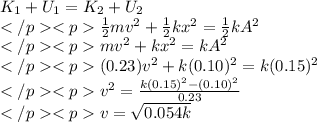
Physics, 24.01.2020 23:31 brinleychristofferse
A0.23 kg mass at the end of a spring oscillates 2.0 times per second with an amplitude of 0.15 m
part a
determine the speed when it passes the equilibrium point.
part b
determine the speed when it is 0.10 m from equilibrium.
part c
determine the total energy of the system.
part d
determine the equation describing the motion of the mass, assuming that at t=0, x was a maximum.
determine the equation describing the motion of the mass, assuming that at , was a maximum.
x(t)=(0.075m)cos[2π(2.0hz)t]
x(t)=(0.15m)sin[2π(2.0hz)t]
x(t)=(0.15m)cos[2π(2.0hz)t]
x(t)=(0.15m)cos[(2.0hz)t]

Answers: 1
Another question on Physics

Physics, 22.06.2019 02:30
Which feature of a heating curve indicates a change ofn state
Answers: 1

Physics, 22.06.2019 11:00
Arowboat passenger uses an oar to push the boat off the dock by exerting a force of 40n for 3.0s. what impulse acts on the boat.
Answers: 1

Physics, 22.06.2019 11:30
1. a camcorder has a power rating of 19 watts. if the output voltage from its battery is 7 volts, what current does it use?answer units 2. a 1.5m wire carries a 6 a current when a potential difference of 57 v is applied. what is the resistance of the wire? yourunits 3. a clothes dryer uses about 2 amps of current from a 240 volt line. how much power does it use? yourunits 4.
Answers: 1

Physics, 22.06.2019 15:00
Astudent throws a water balloon with speed v0 from a height h = 1.76 m at an angle θ = 21° above the horizontal toward a target on the ground. the target is located a horizontal distance d = 9.5 m from the student’s feet. assume that the balloon moves without air resistance. use a cartesian coordinate system with the origin at the balloon's initial position. (a) what is the position vector, rtarge t, that originates from the balloon's original position and terminates at the target? put this in terms of h and d, and represent it as a vector using i and j. (b) in terms of the variables in the problem, determine the time, t, after the launch it takes the balloon to reach the target. your answer should not include h. (c) create an expression for the balloon's vertical position as a function of time, y(t), in terms of t, vo, g, and θ. (d) determine the magnitude of the balloon's initial velocity, v0, in meters per second, by eliminating t from the previous two expressions.
Answers: 3
You know the right answer?
A0.23 kg mass at the end of a spring oscillates 2.0 times per second with an amplitude of 0.15 m
Questions

Mathematics, 27.05.2021 05:20


Health, 27.05.2021 05:30

Mathematics, 27.05.2021 05:30

Spanish, 27.05.2021 05:30

Mathematics, 27.05.2021 05:30

Chemistry, 27.05.2021 05:30


Mathematics, 27.05.2021 05:30

Mathematics, 27.05.2021 05:30



Biology, 27.05.2021 05:30

Mathematics, 27.05.2021 05:30

History, 27.05.2021 05:30




Mathematics, 27.05.2021 05:30



 and
and 





 is the phase angle to be determined by the initial conditions. In this case, the initial condition is that at t = 0, x is maximum. Therefore,
is the phase angle to be determined by the initial conditions. In this case, the initial condition is that at t = 0, x is maximum. Therefore, 

